Text
LHAT Collection - Photos
As I worked to process the LHAT Collection, its boxes were filled with a multitude of photographs: small and large, old and new, color and black and white. Having a life-long interest in photography myself, this has been my favorite aspect of the material thus far. The subjects feature just as many dilapidated details in need of care as newly remodeled fixtures, ready for grand-reopening celebrations. All of these photos, on the surface, are documents; many have been taken to record the state of structures, serving as a note as to what must be repaired. Postcards and pamphlets feature images that communicate a theatre’s grandeur within the confines of a 4x6 rectangle. Portraits of theatre owners and directors mark fashions of another time--however, all faces reveal pride in their dedication, love for their work. The respect for these houses in which we preserve today is powerful. Photographs allow us not only a window to a theatre’s past, but a timeline of evolution; a reminder of the humanity of the theatre and the everlasting experience it has created for itself. Below are a few examples of photographs that stood out to me during processing, and why I found them to be a source of intrigue.


The Kimo Theatre in Albuquerque, New Mexico is an auditorium with an Aztec influence only found in the south west. These black and white photos share an atmosphere of authentication; symbols, wall art, skulls, wood, and various patterns all breathe life into this theatre, and the photographs present do a wonderful job at documenting its details.
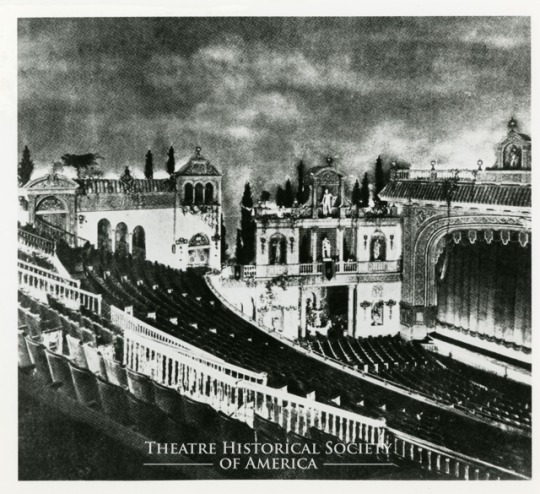
These photographs of the Astro/Paramount Theatre in Omaha, Nebraska have an atmospheric air to them; the photos do a wonderful job at portraying a vast amount of space within the hall. Upon further inspection, the prints almost look like charcoal drawings--its a little difficult to decipher whether or not they are simply grainy, or the drawings had been printed on photo paper.

These color photos of the New Amsterdam Theatre in New York document its restoration, taken for promotional material as a means to celebrate and publicize an extraordinary transformation. Each photo, taken from the same perspective and placed side-by-side, shows a detailed analysis into the work that was done on what existed before.
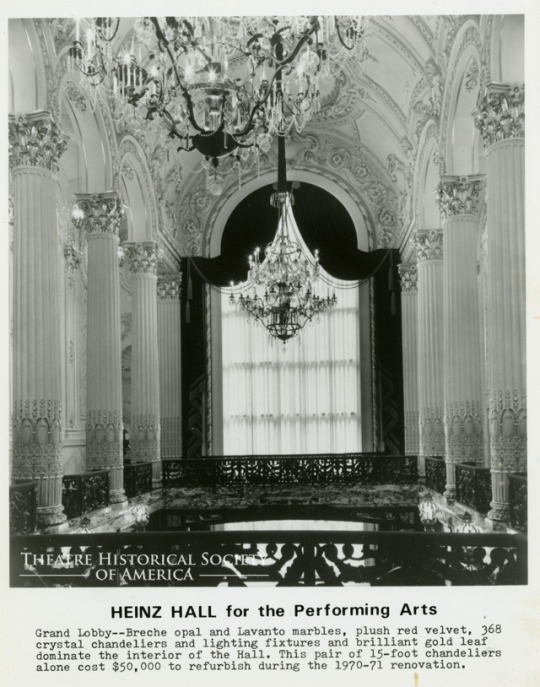
This black and white photo of the chandelier in Pittsburgh’s Heinz Hall stood out to me because of its starkness: the image has very little contrast, making the chandelier stand out against the bleak backdrop. This image is part of a series pertaining to newly renovated details throughout the hall. Aesthetically, I admire the descriptive text at the bottom, as it is both informative and unique, typed directly onto the glossy photo paper.
#Theatre Historical Society#American Theatre Architecture Archive#League of Historic American Theatres#photography#photographs#new mexico#albuquerque#Kimo#theatre history#theater history#movie theatres#movie theaters#pennsylvania#pittsburgh#Heinz Hall#Heinz Hall for the Performing Arts#nebraska#omaha#paramount#New York City#new amsterdam#manhattan
7 notes
·
View notes
Text
Geary Theatre - San Francisco, CA

San Francisco’s Geary Theatre specialized in theatre performance, and has been a staple of the city since 1910. Having been built shortly after the San Francisco’s earthquake and fire of 1906, the Geary was no stranger to living in dangerous territory. Nearly eighty years after its repair and reopening in 1910, the Geary faced near-catastrophic damage once more in yet another earthquake.

I happened across an image of the theatre taken after the earthquake occurred while processing the LHAT Collection; it is an image that strikes me as stark, one that represents the fragility of things we build, no matter how sound we think they may be. In the event of natural disasters, it is next to impossible to predict the amount of damage the earth can produce. However, it reinforces the importance of maintaining these stunning structures and not taking them for granted.

The Geary was reconstructed following the earthquake, and still remains in operation today as a part of the American Conservatory Theater, a nonprofit theater company in San Francisco. Nearly $30 million was raised to make the renovations possible. The Geary’s reconstruction and continual success to the present day is a reminder that any wreckage can be recovered with enough care.
Sources:
http://www.act-sf.org/home/box_office/geary.highResolutionDisplay.html
#Theatre Historical Society#American Theatre Architecture Archive#theatre history#theater history#movie theatres#movie theatre#movie theater#movie theaters#san francisco#geary theatre#american conservatory theater#earthquake
4 notes
·
View notes
Text
Theatre Concessions - A Brief History
Snacks and a show go hand in hand! Today, theater concessions can make up to 50% of a theater’s profits. However, concessions in theaters weren’t always a staple. Initially theaters sought to exhibit the utmost class in order to attract highbrow consumers - the idea of salty snacks and sweet treats didn’t quite scream “panache”. Often, snacks were purchased from street vendors and hidden under coats and in purses to be enjoyed during a screening.

It wasn’t until the Great Depression that concessions as we know them began to take shape. Ticket sales were sorely lacking, and theater owners realized just how much snack sales could influence their income. Available fare began with a small selection of candies including Twizzlers, Milk Duds, and Raisinets, with the everlasting popcorn making an appearance shortly after.

Popcorn is by far the most popular concession stand snack, withstanding the test of time. A recent trend, however, combines the theater experience with dining--full menu and alcoholic beverages included. This is the concept of the Alamo Drafthouse theater chain, located in several states. The Commodore Theatre in Portsmouth, Virginia also carries the “fine dining” label, boasting a menu containing sandwiches, pizza, desserts, beer, and wine. As I processed the materials for the Commodore within the LHAT Collection, I found the following menu (see above). Take a look at the items available, as well as the prices, and see how concessions have evolved!
Sources:
http://www.historictheatres.org
http://www.bonappetit.com/trends/article/a-history-of-movie-theater-snacks-in-america
http://filmmakeriq.com/lessons/the-science-and-history-of-popcorn-the-snack-that-saved-the-movies/
#Theatre Historical Society#American Theatre Architecture Archive#League of Historic American Theatres#theatre history#theater history#movie theatres#movie theaters#concessions#snacks#candy#popcorn
3 notes
·
View notes
Text
LHAT Collection
The League of Historic American Theatres, or LHAT, is an organization much like THS that works to maintain landmark theaters throughout the country, prioritizing the preservation of their history for generations to come. Founded in 1976, LHAT lends its membership to 380+ theaters with historic status.
LHAT’s archival collection is currently housed in THS’s archive. Content of this collection includes newspaper articles, photographs, and documents on the restoration and/or maintenance of member theaters, with emphasis on their architectural significance. A few notable theaters include:

An array of Paramount Theaters, an iconic chain that has roots back to the early 1900s, with many still standing today.
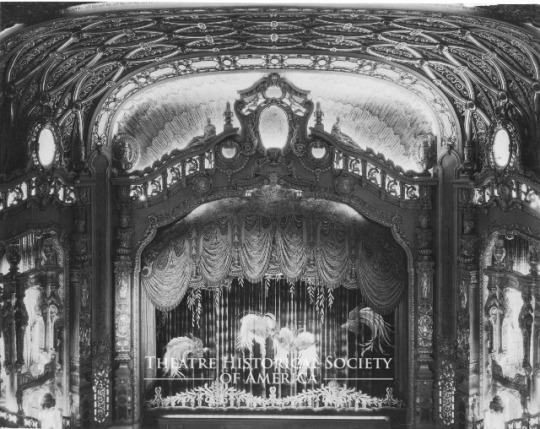
The Tivoli Theatre, and the infamous Ford’s Theatre in our nation’s capital also reside amongst LHAT’s members.
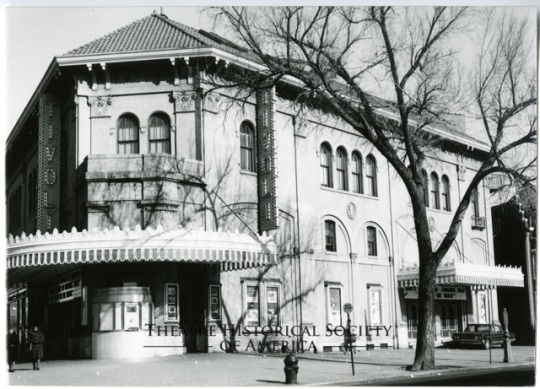
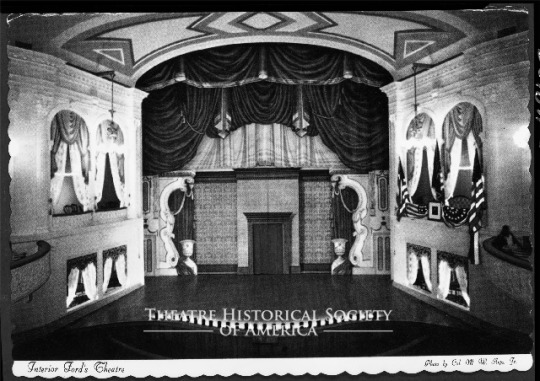
The collection even houses theaters in Canada, such as the Elgin and Winter Garden in Toronto. The ceiling of this theater is composed of a canopy of live beech leaves!

Many treasures have yet to be uncovered in the LHAT collection, which is currently being processed to ensure that each artifact can be readily accessible for research, and to allow the wealth of knowledge surrounding these cultural centers to continue far into the future.
#Theatre Historical Society#American Theatre Architecture Archive#league of historic american theatres#theatre history#theater history#architecture history#architecture#design#design history#movie theater#movie theatre#archives
2 notes
·
View notes
Photo

“Elephants run wild in Harlem Streets: Baby elephants from backstage of a vaudeville theatre bolted while waiting their turn for animal act.” November 1930
From the back of the photo
#elephant#vaudeville#Vaudeville History#theatre#theatre history#theater#theater history#Theatre Historical Society#American Theatre Architecture Archive
2 notes
·
View notes
Text
Stage Show Collection - Connecting the Dots
Karen, one of our wonderful volunteers is continuing to process our collection of 1930s stage show material. This collection features photos of set designs and costumes from a number of productions that toured through Chicago, New York, and elsewhere.

While processing a separate collection I ran across some material that addressed certain productions in the Stage Show Collection. The photo above and the one below are from a production called “Modes & Models”

Alone the production photos only tell us so much, but the documents in the other collection provide a list of scenes and production notes for each one.

Another production that shows up in both collections is one called “Drag In the Dragon.” We have a number of production photos that just made me scratch my head wondering what the production could be about. Thankfully I ran across a review in a magazine that gives a brief description of the show as well as the scene featured below.
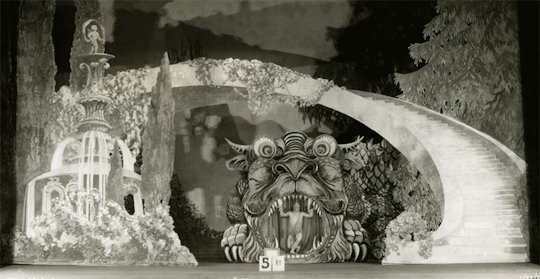
According to the review the creature coming out of the dragon’s mouth was a demon which started a dance routine with a princess.
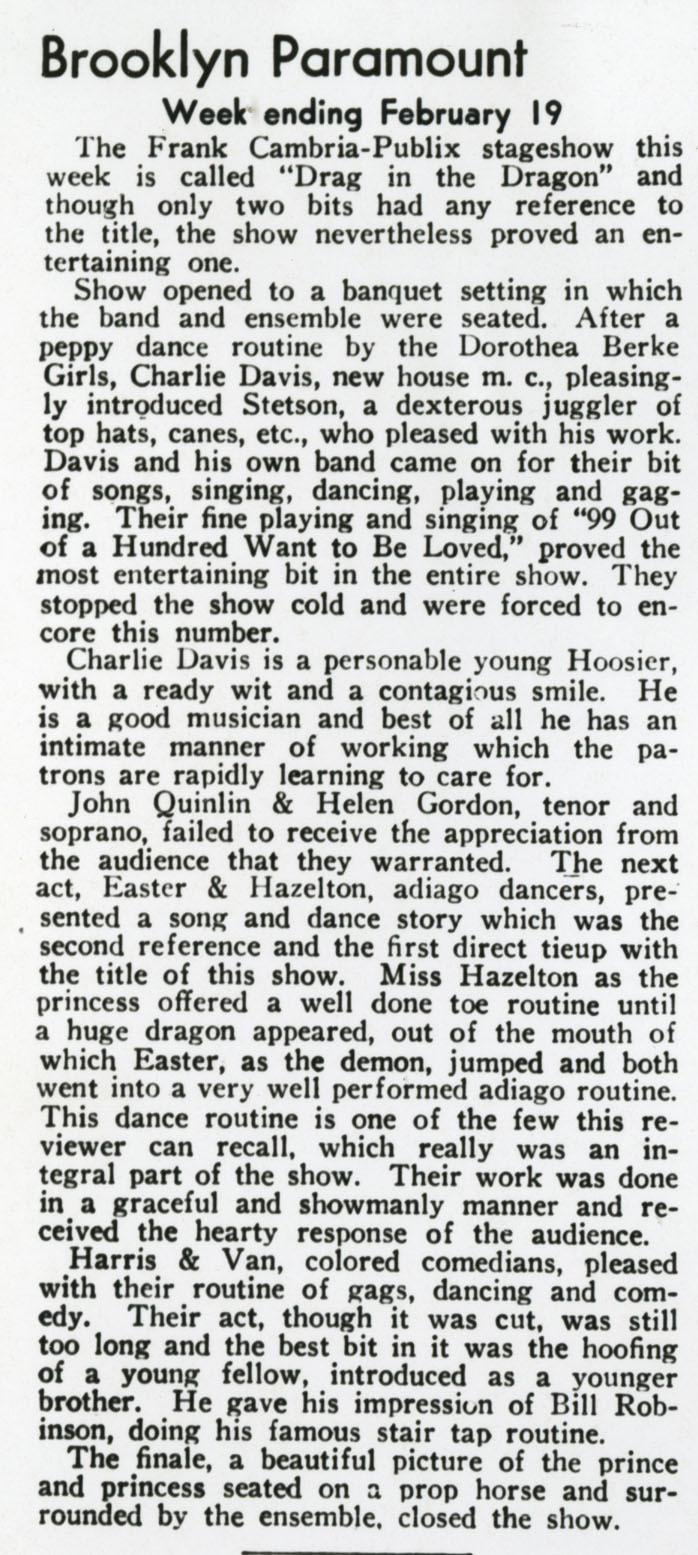
In both cases there is still a lot we don’t know about the productions but finding these sorts of clues helps create a clearer picture of what was going on.
Discover more at historictheatres.org
#Theatre Historical Society#American Theatre Architecture Archive#theatre history#theater history#production#set design#scenic design#costume#movie theatres#movie theaters#preludes#stage show#theatre#theater
2 notes
·
View notes
Text
Roof Garden Theatres
In the late 1880s inspired by European designs architects and building planners decided to make use of a structure’s roof as an additional place to provide leisure or entertainment to patrons. Early versions of these theatres began to populate Broadway venues and mixed entertainment and socializing. Open air layouts (with some covering for the entertainers) decorated with plant life and lighted trellises (often arched ones) were common among early Roof Garden theatres. These early theatres sat somewhere between 400 and 2,000 patrons and were made accessible by the still recent invention of the elevator.

As this design trend developed it the roof garden theatres became enclosed but many of the decorative elements remained. Into the early 1900s there was still a small demand for multiple auditoriums per building (this was long before the era of twinning theatres or multiplexes), architects began simply stacking one theatre on top of the other.

The Proctor’s theatre in Newark, NJ was an eight story building that housed the Lyceum (later the Penthouse Cinema) on the upper four floors of the building. In the shot above you can see the full Proctors building, and the windows at rear of the Lyceum auditorium at the back of the structure attached to the main theatre entrance but rotated 90 degrees (detailed shot below).

Below is a photo of the auditorium of the Lyceum, you can see the arched trellis spanning the theatre that was borrowed from the open air designs. The painting and decorative elements all play on the early open air roof garden designs. The canopy of the theatre was loosely hung fabric that suggests clouds, giving an outdoor feel.

There were a number of other double-decker theatres built throughout the early 20th century, notably the Elgin & Winter Garden theatres in Toronto, and the Century & Valencia in Baltimore, Maryland. You can see the theatre’s marquee below advertising films at both the Century and the Valencia.
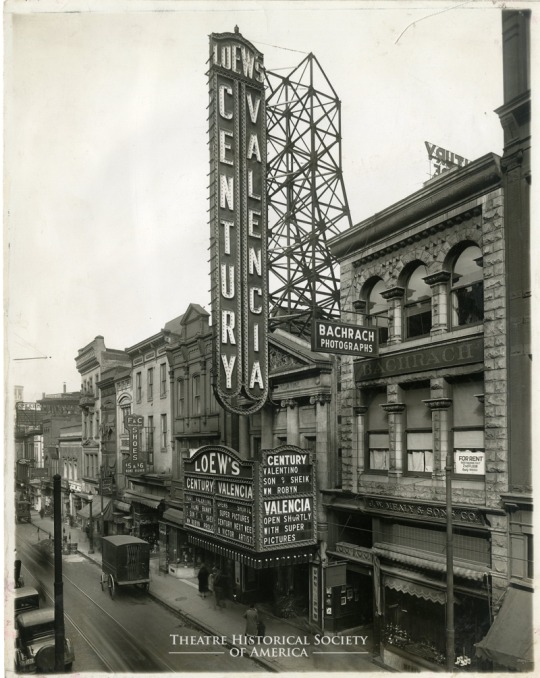
Roof garden theatres can be seen as design that directly influenced the atmospheric architecture style popularized by architect John Eberson. Learn more about theatre design and much more at historictheatres.org
#Theatre Historical Society#American Theatre Architecture Archive#theatre history#theater history#theatre architecture#theater architecture#architecture#architecture history#design#design history#atmospheric#roof garden#newark#new jersey#proctors#baltimore#maryland#valencia#loews#RKO
6 notes
·
View notes
Text
Art Deco Theatres
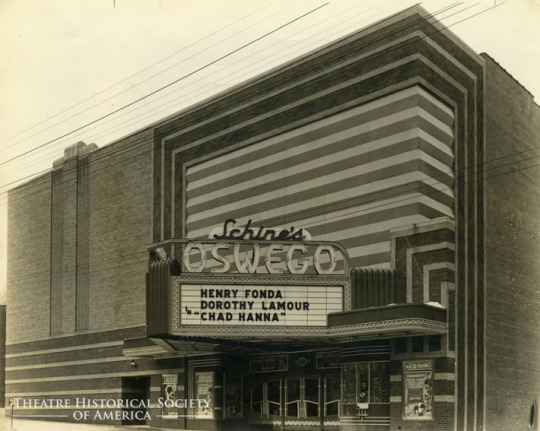
Theatre architecture in the 20s, other disciplines, embraced the clean and streamlined design that was Art Deco. This was a sea change from the palatial opulence of much of the early 20th century design that treated every surface as something to decorate.
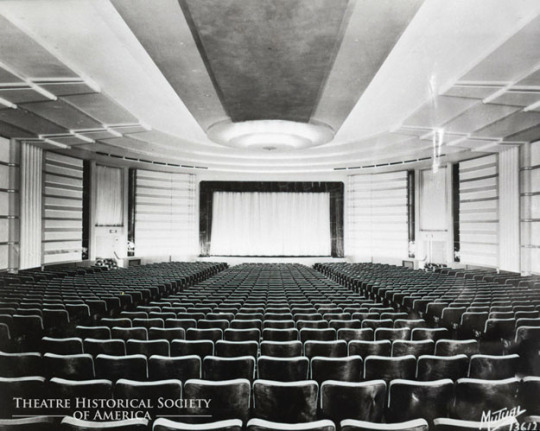
The following are excerpts from introduction to the 1989 THS annual “Glamour, Glitz and Sparkle: The Deco Theatres of John Eberson” by Richard Guy Wilson - Architecture Historian - University of Virginia.

“The term Art Deco has come to mean the attempt in the period between the two world wars to forge a new visual aesthetic, not only in architecture, but in the other design arts as well.”

“In the decades of the 20s and 30s, Americans were bombarded with the belief that a new age had come into being, a modern age controlled by machine and modern technology.”

“The full experience for many Americans came inside the new movie theatre...There one could really not just see, but feel the full kinetic impact, the physical and sensual three dimensions of modern design.”
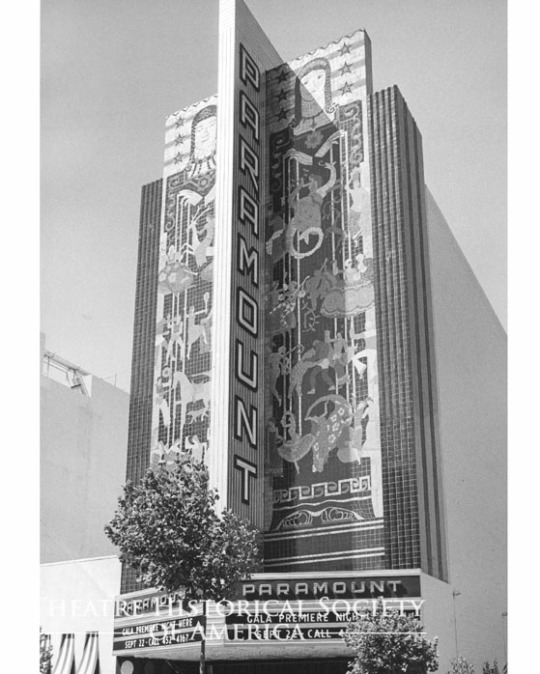
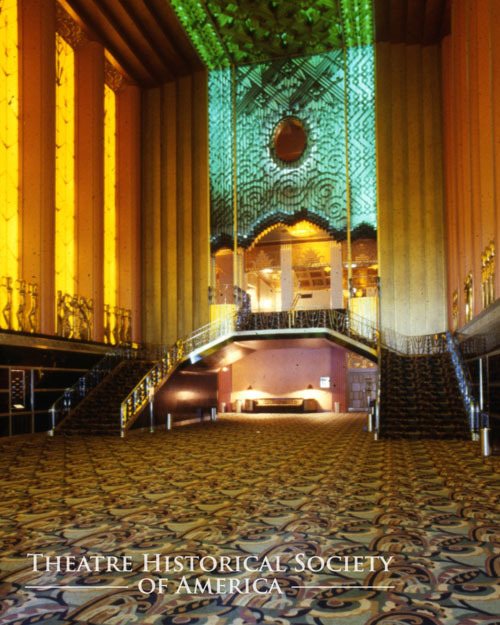
Photos of the Oswego Theatre in Oswego, NY
Lake Theatre in Oak Park, IL
Beverly theatre in Chicago, IL
Paramount Theatre in Aurora, IL
Penn Theatre in Washington D.C.
The last two are of the Paramount Theatre in Oakland, CA
#Theatre Historical Society#American Theatre Architecture Archive#architecture history#design#design history#theatre history#theater history#oswego#oak park#chicago#aurora#washington d.c.#oakland#paramount#penn#beverly#architecture#art deco#art
100 notes
·
View notes
Text
Vintage Movie Advertisements
We recently received a collection of great film advertisements that really blur the line between form and function. The three here are for films released in 1932. The movable features make perfect fodder for animated GIFs. It makes one wonder if these were put together by hand and how many were made.
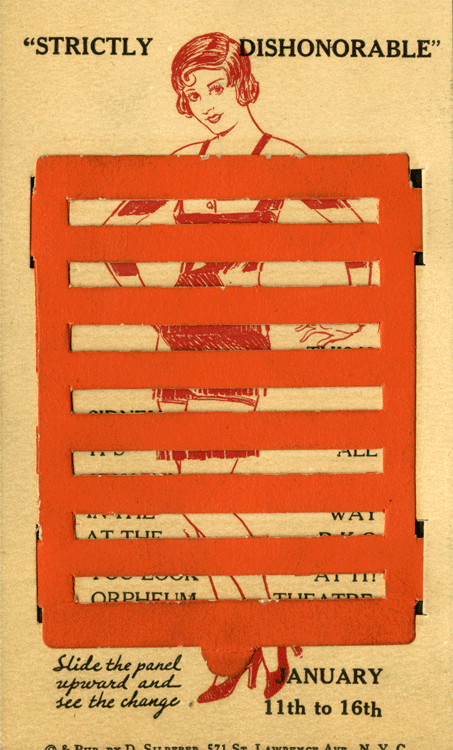
“Strictly Dishonorable”

“Lady With a Past”

“Fireman Save My Child”
#Theatre Historical Society#American Theatre Architecture Archive#movie advertisements#Vintage#vintage ads#movie theatres#movie theaters#theatre history#theater history#economy novelty & printing#novelty#rko
145 notes
·
View notes
Text
The Dynamo Room!
The Keith’s theatre in Boston was named after B.F. Keith (the ‘K’ in the future company RKO Pictures, though Keith died over a decade before that company was founded) a New Hampshire showman who struck big in the vaudeville era. Keith has been credited with founding the continuous performance style of programming, at the least he was an early adopter. The Keith’s theatre packed in guests to its huge (especially for the time) auditorium seating 3,000 while it was open from 1894-1952.

One aspect of theatres that rarely gets featured is the mechanics, and the Keith’s theatre had some state of the art equipment powering the building. Thirty-two feet below street level in a sub-cellar resided the Dynamo Room. This featured 3 Ideal engines powering 3 100-kilowatt dynamos that provided the energy for the nearly 5,000 incandescent lights and 40 arc lamps throughout the theatre. Two of the dynamos were operational and one served as backup. The room was staffed by a bevy of finely mustachioed men.

In the back of the Dynamo Room was the switchboard, seen above, that controlled the dynamos, ventilators, pumps for fire service, fans, boiler room, machine shop, among other operations in the theatre.
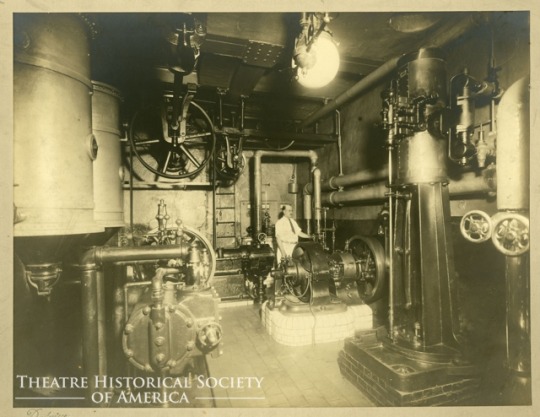
Also seen is the engine room and what is noted as the cleanest coal fired boiler room one THS researcher has ever seen.

#Theatre Historical Society#American Theatre Architecture Archive#theatre history#theater history#movie theatre#movie theater#boiler room#boston#mechanic#engine room#dynamo#machine history
3 notes
·
View notes
Text
Research Fellowship
The deadline for the annual DuBuque Research Fellowship has been extended to April 15th.
Established in 2012 to support scholars conducting research in the Society’s archives, the Fellowship awards certificates and a cash award of $1,500 to support related expenses to visit the THS archive in Pittsburgh, PA.
Past fellowship projects include research on the theatres of Ben Schlanger, the theatre murals of Louis Grell, documenting the theatres of Utah, and others.
Find fellowship rules and procedures and how to apply here.

Above - Thomas DuBuque, former THS President
1 note
·
View note
Photo


Sometimes you run across some strange material in your collections. Like this publicity shot from a 1930 film called “Madame Satan.”
Theodore Kosloff was a Moscow born ballet dancer who came to American and had a career as a dancer, choreographer, and actor. He worked with Cecil B. De Mille on a number of films with “Madam Satan” being his last credited acting role. The movie was a commercial flop about a wife trying to win back her philandering husband’s affections by posing as a sultry masked character named Madam Satan. How a production number featuring the personification of electricity fits in, I do not know and am happy to let my curiosity run with that. Luckily youtube has the production number available for viewing and it is more bizarre than I would have guessed.
youtube
#Theatre Historical Society#American Theatre Architecture Archive#theatre history#theater history#movie history#cecil b. demille#hollywood#hollyweird#electricity#theodore kosloff#ballet#madam satan
7 notes
·
View notes
Text
Is This Safe?
Each theatre is a marvel of design and engineering. Building a sound structure is only part of the equation. Architects must also factor in the stress on certain areas when the theatre is at capacity, consider optimal sightlines, and craft an aesthetically pleasing building too. Balconies add another level (no pun intended) of complexity to the mix. In order to safely add them support posts were commonly used in their construction, but they could obscure sightlines or crowd exit lanes, as seen below.


At the end of the 19th century the concept of cantilever balconies were introduced to theatre construction. A cantilever balcony uses a rigid beam anchored only on one side that eliminates external support such as supporting columns. Thought to have been first introduced in British theatre design, one of the earliest known examples in America is the New Amsterdam Theatre in New York, which opened in 1903.
Architects Rapp & Rapp and the Balaban & Katz chain took the cantilever balcony several steps further with the construction of the Chicago theatre and other movie palaces. The entire capacity of the New Amsterdam auditorium is 1,702 seats, the Chicago theatre held nearly that in its balcony with 1,504 seats. The Chicago has a huge cavernous auditorium that is 7 stories tall with the stage measuring over 60 feet, it was said to be the largest movie palace at the time of its opening in 1921.

Seeing a balcony as large without supports must have been a jarring sight, surely they would collapse under its own weight, to say nothing of when it was full of people. Now they are commonplace, but imagine seeing one for the first time when you were used to columns holding them up. The load capacity of the balconies would have been calculated by the engineers, but how to assuage the public’s concern? One way to test the load capacities is with sandbags. It is speculated that Balaban & Katz saw these sandbag tests as a public relations opportunity and circulated photos of these tests to assure the public that the massive cantilever balconies in their theatres were indeed safe.
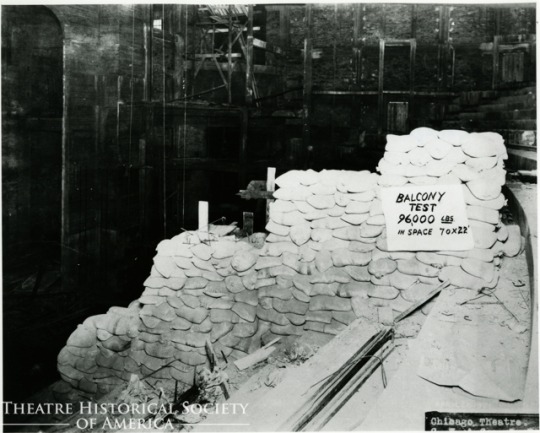

Above are sandbag test photos from the Chicago Theatre and the Southtown Theatre built by Rapp & Rapp in 1931 for Balaban & Katz
#Theatre Historical Society#American Theatre Architecture Archive#theatre history#theater history#movie theatres#movie theaters#Rapp & Rapp#rapp and rapp#Balaban and Katz#Balaban & Katz#chicago theatre#engineering#cantilever#balcony
26 notes
·
View notes
Text
A Grand Roof Sign

Happy Friday!
Here is an animation of several images we have in our archive of the roof sign of the Grand Lake Theatre in Oakland, CA. Full disclosure, I have never seen the sign in action so this is my best guess approximation of how it would look.
Roof signs used to be common fixtures of theatres and business of the early-mid 20th century. This particular sign is said to have nearly 3,000 bulbs!
#Theatre Historical Society#American Theatre Architecture Archive#theatre history#theater history#movie theatres#movie theaters#signs#oakland#california#grand lake theatre#lights
7 notes
·
View notes
Photo

Quick photo spread in Motion Picture News, 4 November 1922, noting the opening of Sid Grauman’s Egyptian Theatre, in Hollywood.
I think it’s interesting that this picture palace had no balcony when it was originally constructed. That’s clear from the top picture, but more recent photos show a balcony, which was added later. The original, one-level seating capacity was still quite large, though: 1,771.
For more, check out the theater���s entry at Cinema Treasures.
23 notes
·
View notes
Text
Pekin Theatre in Chicago
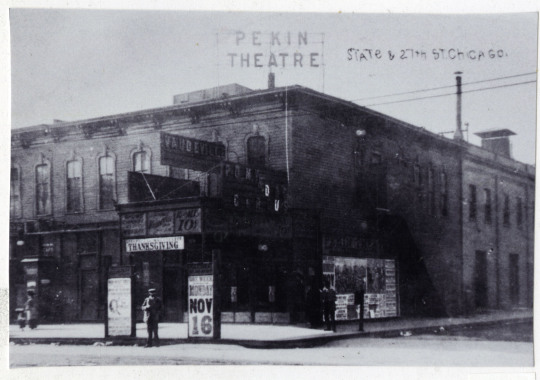
The Pekin Theatre located at 27th and State on Chicago’s south side was one of the country’s first if not first Black owned theatre. It was owned by local businessman Robert Motts who expanded his then saloon to feature an auditorium in 1906.
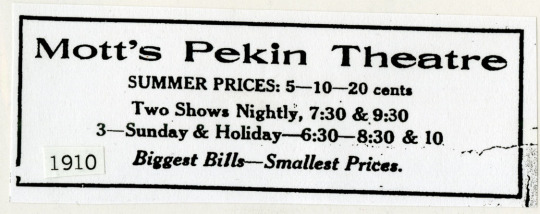
The auditorium allowed him to program theatre, vaudeville, and book musicians. It became a notable place to see jazz acts in the city. Motts passed away in 1911 and theatre was eventually taken over by white owners and converted into a dance hall. Operating until sometime in the 1930s. The building has since been demolished.

Though he operated the theatre for less than ten years his tenure was celebrated and recognized throughout Chicago and his legacy as one of the first Black theatre owners encouraged many to follow.
#Theatre Historical Society#American Theatre Architecture Archive#theatre history#theater history#pekin#robert motts#african american history#vaudeville#vaudeville history#chicago
5 notes
·
View notes
Photo

I would like to imagine a time that using elephants to deliver your daily receipts to the bank was a regular occurrence.
#American Theatre Architecture Archive#Theatre Historical Society#theatre history#theater history#elephant#movie theatres#movie theaters#movie theater#movie theatre
10 notes
·
View notes